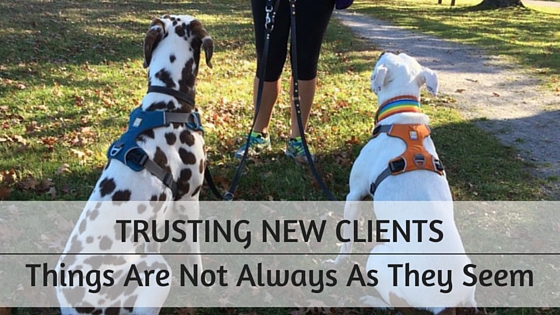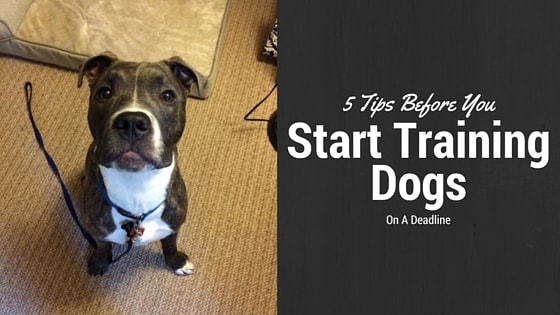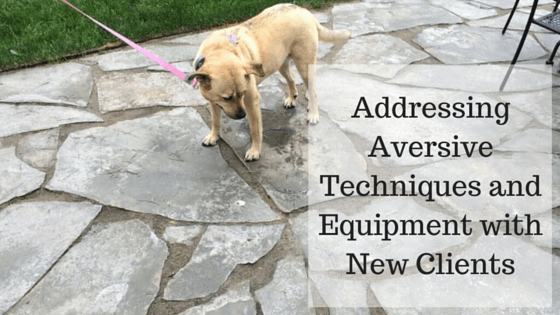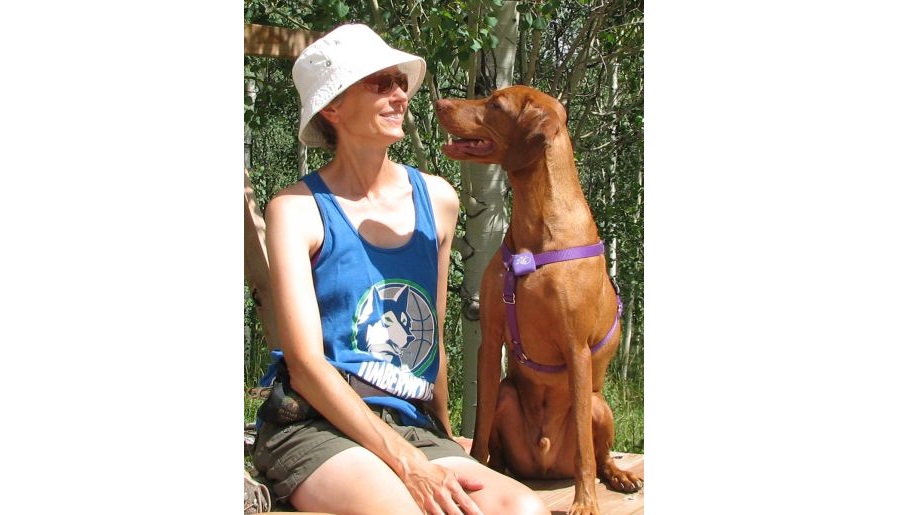![Trusting New Clients: Things Are Not Always As They Seem]()
by Thomas Aaron | Feb 20, 2016 | Business, Training Methods

It is a story often told among dog trainers. It goes something like this:
A prospective client calls and says that another dog trainer – sometimes multiple dog trainers – could not help their dog or said their dog was beyond help. We take the case and find that the dog is indeed help-able. In fact, we do wonders with the dog in a short period of time, and we are perplexed and discouraged that the other trainer (or trainers) almost destroyed the client’s hope for their pet, when in fact the case really was not that difficult.
Recommended Reading: The Importance of Asking the Right Questions to New Dog Training Clients
When we take such cases and succeed in helping a dog, there is a part of us that feels superior – that other trainers in our area are not as capable as we are. Frankly, it feels kind of good, and we can’t wait to herald the news to our other colleagues so that they can be wary of the incompetent, unhelpful trainers who nearly destroyed some pup’s life.
All is well that ends well, right? The dog received the help it needed. The client is happy. We feel more confident than ever. But there often is another side to such stories.
Taking Client’s Comments With A Grain Of Salt
Perhaps the client was indeed telling the truth about the other trainer(s). But stories about multiple trainers failing cause me to be suspicious of the client – especially if my impression is that the dog’s problems are easily remedied.
We need to consider that clients may not always be truthful. They are human (like us), and sometimes they are not above behaving in a way that gets them what they want or makes them feel good (like their dogs).
A case in point: I recently was approached by a prospective client who told me that one of my most trusted colleagues and referral partners had recommended my board-and-train program. According to this client, my colleague thought it would be a better option for this particular dog than her own group class.
When I called my colleague to thank her, I learned the prospective client was lying. In fact, my colleague had this client on the roster for an upcoming, limited-size group class and had no idea the client was still shopping around for trainers.
When questioned about the situation, the prospective client began back-pedaling and telling me more lies to extricate herself from the first one. I decided not to accept this person as a client. If she was willing to blatantly lie to me (she could have just said they would rather do a board-and-train program), then what would she have been capable of unjustly saying about ME? It just didn’t seem worth the risk.
Digging For The Truth
As a rule, when a potential client tells me they have worked with one or more trainers, I require them to tell me who the trainers were, what steps were taken to solve a dog’s behavior issues, and how the dog responded to those steps. (And if I personally know one or more of the trainers mentioned, I might call them to better understand their experience with the client and dog.) If the prospective client is not willing to be forthcoming with such information – or if the information they provide throws up red flags about their own credibility or willingness to follow through with a trainer’s advice – I am better off without them.
Give Colleagues The Benefit Of The Doubt
Professionally speaking, I think it is a bad idea to give credence to unverified testimony against colleagues. Doing so risks us forming (or worse, spreading) false conclusions about them, and it potentially burdens us with deceitful or non-compliant clients. There are two sides to every story, and if we are to make a judgement about the credibility of a prospective client or the professionalism of a colleague, it is only right to get all the pertinent details and understand both sides of the story.
My mission as a professional dog trainer is helping dogs, but sometimes owners need help too. And sometimes helping an owner is showing them that some behaviors are rewarding, whereas others are not.
Have you ever had a similar experience?
Dog Training Business Tips
Receive valuable dog training business tips and resources right in your inbox! Subscribe to The Modern Dog Trainer now by submitting your name and email below. Don’t forget to let us know what you want to learn more about!
![Trusting New Clients: Things Are Not Always As They Seem]()
by Thomas Aaron | Feb 3, 2015 | Business

Five Things To Consider
There are numerous ways for dog trainers to provide their services, and each has its benefits and drawbacks. In addition to group classes, in home training, and day training services, trainers also can provide board-and-train services.
For clients, having their dogs boarded and trained usually is more expensive than other modes of training, but it is a viable option for those who have hectic schedules and find attending group classes or scheduling private coaching unfeasible. (As trainers, we often become agitated about clients who cannot make time to train their dogs. However, board and train services can lay important groundwork with the dog and can be used in conjunction with in-home training or group classes to help busy clients achieve their training goals more efficiently.)
But before you decide to add board and train services to your repertoire, there are several factors you should consider.
Training Dogs On A Deadline
Board and train usually is faster than group classes or private training, because it pushes the dog towards new training objectives daily rather than weekly. Additionally, the training is being performed by professional trainers, who should have better timing and tactile skills than the average dog owner. For those reasons, some people are willing to pay you a premium to accomplish training goals, but they are not willing to give you their dog indefinitely. They will expect you to complete your training goals on a deadline.
For example, while a Level One Obedience course may take five or six weeks in a group class or in-home training scenario, it usually takes no more than two weeks in a board-and-train environment (for the reasons mentioned above). However, there is a certain stress factor involved in working on a deadline that does not lend itself to successful positive reinforcement training.
It is easy to deal with problems and various training interruptions early in the board-and-train process. But problems are not as easy to handle as the training deadline draws closer. Dogs do not learn faster just because you need them to. Your stress level can complicate their learning ability (as they are emotional creatures). So, trainers who offers board-and-train services must understand how to manage their stress levels and patiently keep the training process moving forward.
Getting Results With Dogs, Not People
If a dog is not making progress in a group class or in-home training environment, there are lots of possible reasons. You could blame the owner for not putting in the effort or not following your advice. You could blame the owner’s children for constantly reinforcing the dog’s bad habits. You could even blame the dog … let’s face it, they are not all easy. However, in a board-and-train environment, all blame rests on the trainer if the job does not get done correctly, and clients will not accept excuses unless they are accompanied by a refund.
Remember, boarding-and-training is about training dogs, not people. It requires a person who can train animals effectively and efficiently, not a personal coach. To be sure, there is an overlap in skill-sets in the two disciplines, but those offering board-and-train services cannot exempt themselves from responsibility if the dog does not get trained well and on-time.
Note: While it is possible to negotiate extending a dog’s training time in your program, you must lay a pretty good argument for it, preferably earlier in the dog’s stay with you rather than later.
Skills Training Versus Behavior Modification
In truth, behavior is behavior. Sitting is a behavior. Coming when called is a behavior. Walking calmly on a leash in the presence of other dogs is a behavior. Exhibiting separation anxiety when the owner leaves the home is a behavior — one we would like to eradicate. However, some behaviors are more feasible to work on in a board-and-train environment than others.
A fundamental rule for boarding-and-training is this: If a behavior is not heavily dependent on the dog’s owner, family or environment (that is, if it is just a skill), it probably can be created or modified effectively in a board-and-train program.
Chasing the cat, house training, leash aggression, resource guarding toys from the children, fighting with the other dog in the family and separation anxiety are all examples of behaviors that are difficult to fix in a board-and-train environment. This is because, in one way or another, they all have specific links to the dog’s environment and family.
Now you could do some groundwork on many of these issues in a board-and-train environment (i.e. some impulse control work, some socialization, some counterconditioning, teaching leash walking), but you most likely will not be able to solve the dog’s problem without some follow-up work with the dog’s family in their home environment.
While there are indeed some trainers who specialize in fixing certain complex behavior issues in a board-and-train environment, skills training is where the average board-and-train program can really shine. Sit, down, stay, come, leave it and leash walking are all examples of simple skills that can easily be taught to an acceptable degree in a short timeframe. Board and train can also be a great way to teach certain work- and game-related skills: retrieving, nose work, protection work, hunting, agility. These are not so dependent on the dog’s family and environment; they are just things the dog can know how to do and enjoy.
Setting Expectations And Offering Handover Sessions
There is what a dog knows, and then there is what a dog does — and the two are not always linked. For example, a dog may know how to come when called, but that doesn’t mean he will be willing to in every circumstance. Also, dogs seem to learn that it is rewarding to listen to some people and not to others. For these reasons, it is important to set expectations correctly with owners. You must tell the owner that you will teach their dogs skills and demonstrate those skills when they come to pick up their dog, but you also must explain that some work with them will also be necessary.
The first formal training the owner gets when they pick up their dog should be a very detailed handover session. You might want to compliment the session with handouts that describe everything their dog was taught, proper cues and related hand positions, important principles to follow, etc.
However, many board-and-train specialists sell their board and train package so that it includes one or (optimally) more in-home sessions to help the owner get the hang of handling their newly trained dog, managing the dog correctly, and reinforcing the dog’s newly trained behaviors.
And The Legalities
Some trainers maintain professional facilities where they provide board-and-train services. Such facilities usually must be regulated by one or more governmental entities. For example, in Colorado a boarding facility must be licensed by the Department of Agriculture and by the city government. It also must be well insured, as a lot can go wrong when dogs and people are involved.
Other trainers like to provide board-and-train services in their home. This option can be particularly attractive to clients, as most people would rather have their dog trained in a cushy home rather than a kennel. For this reason, it also is attractive to trainers (in addition to the fact that a home has much fewer operational expenditures than a facility).
However, there are a few things you should check on before deciding to offer boarding and training at your home. First, you will want to determine the degree to which you must submit to regulatory and licensing authorities. Second, you will want to make sure you are not running amok of your community covenants. And third, you will want to make sure your insurance will cover it.
Clients may not think of these things while times are good. But if something goes wrong (and it probably will, according to Murphy’s Law) and they decide to sue you, you can be sure that all of these things will be brought to light, and your reputation as a professional will rest on how well you have adhered to them.
Do you offer board-and-train options? If so, what other factors do you think are important to consider?
Get Dog Training Business Tips!
Receive valuable dog training business tips and resources every week! Subscribe to The Modern Dog Trainer now by submitting your name and email below.
[mc4wp_form]
![Trusting New Clients: Things Are Not Always As They Seem]()
by Thomas Aaron | Dec 18, 2014 | Communication

While dog training based on positive reinforcement is quickly gaining mind share, it is not the only game in town. Dog training philosophies range from very aversive, punishment-based paradigms to those that strive to be completely force-free in their approach. And somewhere in the middle of this range, there are trainers who identify themselves as “balanced” to describe their belief that effective dog training requires the use of all four of B.F. Skinner’s learning quadrants (positive reinforcement, negative reinforcement, positive punishment, and negative punishment).
The truth is some of the best behaviorists and behavior analysts of our time have refused to completely disavow punishment in dog training, and most dog trainers who really think it through will acknowledge that not all methods that fall into the positive punishment or negative reinforcement quadrants are inhumane. For example, here is an excellent summary of Dr. Susan Friedman’s “Humane Hierarchy” of dog training. But pretty much all positive reinforcement trainers recognize that methods which empower dogs to make and be rewarded for “correct” decisions tend to be quicker, more effective, longer lasting, and more humane. These methods primarily reside under the umbrella of positive reinforcement.
As positive dog trainers, there are a number of situations where we will find ourselves face to face with people or tools dedicated to aversive methods. For example:
- In shelters and rescues that utilize a variety of trainers from the community. It is not uncommon to find shelters that have adopted aversive methods on the recommendation of available, local aversive trainers.
- In the client’s home when they inform you they have tried aversive equipment or other aversive trainers. And do not be surprised when they tell you some of the trainers or equipment have yielded some degree of success, which they do not want to lose.
- Your client says things that indicate they have bought into the methods of aversive celebrity trainers. On television, such trainers seem to get near-instantaneous results. It only makes sense that a client may have tried to emulate these trainers.
- You might find yourself in a conversation with an aversive trainer. Whether in your community or online, it is difficult to avoid the diversity that exists among dog trainers.
Here is a brief guide about what you should or should not do in these situations.
- Don’t say aversives do not work. It is true that aversives have a failure rate and potential side-effects. Positive trainers have a failure rate as well, often a side-product of a lack of trainer experience or a lack of client follow-through. However, aversives do indeed work, otherwise they would not have been the predominant method of training dogs until the recent growth of positive training mind share. In fact, aversive trainers sport a lot of major titles and accomplishments in nearly every dog sport niche.
- Don’t be critical of the client. The owner would not have called you had they not realized they needed help. They have recognized that what they have been trying is not working, and they are humble enough to ask for YOUR help. Plus, they are indeed your bread and butter.
- Explain the potential side-effects of using aversives. There are many reasons people may be willing to avoid using aversives. For example, aversives might create an unwanted association between the punishment and whatever the dog happens to be looking at; or it could cause complications in the bonding between the owner and the dog.
- Be professional in your discussion of aversive trainers. Nothing turns off a client more than being unprofessional. One aspect of being unprofessional that is difficult to recover from is speaking badly of other trainers. Simply state that you know of the aversive trainer (if you do), that you understand what their perspective was (if you do), and that your take on the problem and how to solve it is a bit different.
- Challenge the client to give your positive approach a try. When the positive approach and its benefits are explained in a clear, educated fashion, most clients are willing to give it a try. Ask the client to bare with you for a few weeks and apply themselves to your method.
- Don’t get in over your head. Some training goals are easier to reach than others. For example, it is easier to teach a dog to sit-stay than it is to cure leash reactivity. If you are not accomplished at working with a particular issue, refer your case to a positive trainer who is — and shadow that trainer if possible. By doing so, the positive approach gets a fair shot, as does the client. And you get to learn something.
We’d love to hear what you have learned about responding to aversive techniques in your own dog training practice in the comments below!
Get Dog Training Business Tips!
Receive valuable dog training business tips and resources every week! Subscribe to The Modern Dog Trainer now by submitting your name and email below.
[mc4wp_form]
![Trusting New Clients: Things Are Not Always As They Seem]()
by Thomas Aaron | Dec 5, 2014 | Business

Copyright The Light Of Dog LLC. All Worldwide Rights Reserved.
An Interview With Sue Brown On Writing A Dog Training Book
Writing a book about dog training can help you to establish yourself as an industry authority in your community and beyond. But what does it take to write a book? We asked Sue Brown, an accomplished dog trainer and author of Juvenile Delinquent Dogs: The Complete Guide to Saving Your Sanity and Successfully Living with Your Adolescent Dog and Ask the Trainer to talk to us about her own experience as an author.
When it comes to dog training in Denver, Colorado, Sue Brown sets a standard of professionalism that serves as a model for the up-and-coming trainers in her community and makes her a trusted colleague of the more experienced trainers. She holds certifications through the International Association of Animal Behavior Consultants and the Certification Council for Professional Dog Trainers. She also is a Canine Good Citizen (CGC) evaluator, and is the co-founder of the Colorado Dog Trainers Network, a networking and training organization for Colorado dog trainers.

Copyright The Light Of Dog LLC. All Worldwide Rights Reserved.
The Modern Dog Trainer: You have written two books, Juvenile Delinquent Dogs and Ask the Trainer. Why did you decide to write these books?
Sue Brown: I wanted to find a way to share my knowledge and experience with a wider audience. In addition, I had known I wanted to write a book for a long time. I enjoy writing and I wanted to do something more in-depth than you can do with a blog. The only thing holding me back was determining the right topics. Once I had an idea I was passionate about, I got started!
TMDT: Why did you choose those particular topics?
SB: I wanted to write a book that had not already been done several times over. As I scoured through the available books, I noticed there were tons of books about puppies and about dogs in general but none about adolescent dogs. And most books are written from the perspective of a “textbook” sort of approach. I wanted something different. My training clients have always appreciated the personal stories I shared about my own dogs, so I wanted to take on a new topic from the perspective of going through the process with my own dog. So I wrote Juvenile Delinquent Dogs as I was raising my Vizsla, Romeo. He gave me plenty of stories to share! As for Ask the Trainer, it was a way for me to compile and share the articles I had been writing for several years that cover a wide variety of topics.
TMDT: How long did it take you to write each of your books?

Copyright The Light Of Dog LLC. All Worldwide Rights Reserved.
SB: The initial draft of Juvenile Delinquent Dogs took one-and-a-half to two years. That was due in part to the fact I was writing it as I was raising Romeo and I wanted to cover that entire process as it was fresh in my mind. In addition, my clients knew I was writing the book, so they kept giving me more ideas to add. The edits and re-writes added another several months.
Ask the Trainer was a compilation of articles I had written over time for a rescue group newsletter, so that was written in stages over several years.
TBDT: What was the most fulfilling thing about writing your books?
SB: I have always loved to read. As a child, I could sit and spend an entire afternoon reading a book from start to finish. So it was very fulfilling to see an actual book that I had written myself!
TBDT: What was the most difficult thing about writing your books?
SB: I had intended Juvenile Delinquent Dogs to be around 150-200 pages, but it ended up being much longer because there was so much I wanted to share. Even as a student, I always had trouble keeping my written essays short! The hardest part was deciding when to stop. I still think of things I wish I had been able to include. I am happy with the length of it, as it is intended to be a reference book for those living with dogs. I don’t expect people to read it cover to cover in one sitting. It’s meant to be kept handy so it can be referred to over and over again.
TBDT: How do you use your books to augment the dog training you do in your community?
SB: Some people who contact me cannot afford the training that would be most beneficial, so the books are a chance to gain a lot of information and have the ability to go back to it over and over again. Other people will participate in group classes or private training and buy the book to supplement our training together so that they can go back and take time to absorb what we have covered in person. Studies show that people will forget 90% of what they have heard within a week. The books are a way to have that information handy and be able to go back to it at any time.
TBDT: Why did you choose self-publication over traditional publication with a company like Dogwise?
SB: I love to learn, and being able to self-publish and handle that entire process myself was a great learning experience. I certainly made mistakes and would do some things differently next time around. But I am also a Type-A personality, and I knew I wanted control over the entire process. This was my “baby” and I wanted it to be exactly what I wanted!
TBDT: Your first book, Juvenile Delinquent Dogs is available in hard copy and e-book formats, and your second book, Ask the Trainer, is available only in e-book format. What were your reasons for those format selections?
SB: E-books are very popular now, and there are many benefits to them. But I still love being able to hold a book in my hands and carry it with me. So Juvenile Delinquent Dogs was always intended to have a print and e-book version to satisfy both types of people – those who still prefer to hold a book in their hands and those who prefer the economy and convenience of an e-book. For Ask the Trainer, I had seen everything it takes to produce a print version – and the expenses that go with it – and decided to stick with an e-book format for this book. This also gives me the option of easily revising it and adding new articles – which I have done several times already.
TBDT: What advice would you give to those who aspire to write their own books?
SB: My first piece of advice would be to choose a topic about which you are passionate. The process can be long and frustrating at times, so your passion will help you stick with it.
Next would be to talk to others who have done it so that you can avoid some of their mistakes. Also, be honest about how much time and effort you have to put into it. While I am glad I self-published, I honestly do not know if I would do that again. It took a long time and a ton of work, and I don’t know that I could put that much time into another book.
Finally, do not let doubts or anything else hold you back. If you’re passionate about it, go for it!
TMDT: You obviously have worked very hard on your professional certifications. Do you believe it is important for up-and-coming writers to hold dog training certifications?
SB: Our profession is unregulated, so it is very much a buyer-beware market. I believe independent certifications from reputable organizations are a way for us to begin setting standards, minimum qualifications and a set of ethics by which we all strive to abide. Many clients do not know to ask about qualifications, but I am seeing more and more who do. As it pertains to writers, I believe legitimate certifications help lend credibility and demonstrate a degree of expertise, especially for those whose names are not well-known.
TBDT: Can you give us a concise summary of your book-writing process?
SB: Yes, I do it like this:
- Outline your book. Consider what you will cover and how it will be laid out.
- Write it. Review it. Make revisions. Review it again. Make more revisions.
- Have a few people review it. I had 3-4 people review it for me and give feedback. Make revisions.
- Send it to an editor/proofreader. Make more revisions. Send back for re-review. Make more revisions.
- Send to a professional for layout and formatting.
- Determine your final title and design your book cover. Or work with someone to design it for you.
- Review it — and review it again — to ensure everything is perfect.
- Send it to printer.
- Don’t forget to work on your marketing during all of this as well!
- Figure out pricing. It will depend upon how much of this you do yourself and how much you pay others to do. If you are self-publishing, it is a lot more expensive because you are covering ALL of the costs, but you keep more of the profits as well. If you are working with a publisher, you share some costs, and you also receive a smaller percentage of sales.
TMDT: What is next in your book-writing career?
SB: I hope to get started on another book in 2015. You will have to wait to find out the topic!
If any of you have more questions for author Sue Brown, please let us know in the comments, and we will try to get them answered for you. We’d like to extend a BIG thank you to Sue for taking the time to answer our questions. Be sure to check out her books and ebooks!
Get Dog Training Business Tips!
Receive valuable dog training business tips and resources every week! Subscribe to The Modern Dog Trainer now by submitting your name and email below.
[mc4wp_form]
![Trusting New Clients: Things Are Not Always As They Seem]()
by Thomas Aaron | Nov 17, 2014 | Business
Side Services Dog Trainers Can Offer To Boost Profits
If you are looking for a way to earn some extra income, adding some new services to your current offerings can increase your clientele, increase your profitability and ward off monotony. These are three potential side services dog trainers can offer and some suggestions about how you might market them. Each of these ideas easily deserves its own article — or even its own book — but the following information will help you see some of the possibilities available to you.
Lectures & Workshops
If you’ve been training dogs for a while, you probably have developed your own way of talking about various issues. Perhaps you have come up with unique analogies to describe dog training tasks or developed effective methods for solving tricky problems. Not only is your wisdom useful to the average dog owner, but even seasoned trainers can benefit from fresh perspectives on old problems. Alternatively, if you are shy about sharing your own wisdom, you can host a speaker from elsewhere to provide knowledge to your community. Either way, you position yourself as someone striving towards the cutting edge of dog training – and you can earn some extra money, too.

Michael Shikashio presenting at the 2014 APDT Conference.
There are some easy ways to advertise local lectures and workshops. Your own social network can be very useful for posting announcements (the more locally you can filter your announcement, the better). If you are already advertising your website, your advertising dollars will be more useful if your website has some interesting lectures listed on it. Also, local bulletin boards – particularly if they are in pet-industry establishments – can be a great way to make your community aware of your offerings.
Since lectures and workshops are meant for multiple attendees, it is a good idea to keep the price affordable for individuals and derive your profit from drawing a large audience. To provide some extra information on how a lecture could be set up, here is how one company describes its lectures to augment its dog training in Denver.
Dog Selection Assistance
Potential clients sometimes call to scope out dog training services before ever purchasing or adopting a dog. As a dog trainer, you already have a good feel for the factors that influence compatibility between dogs and families. Instead of just competing for their dog training business, become their advocate and help them find the right dog. This is a great way to earn extra money while practically guaranteeing yourself their dog training business once they finally acquire their new dog.
Of course, calls like those mentioned above are good opportunities, but there are other ways to make your community aware of your dog-matching service. In addition to making services known on your website and in your social networks (see above), you can capitalize on relationships you have with animal rescues and shelters. They typically are interested in placing animals in compatible homes and may be willing to let you offer your services through them. Additionally, well-networked dog trainers often receive news of available litters of puppies through breeders in their communities. Serious breeders are always concerned about their pups ending up in the right home, and they may be interested in using you to match up prospective owners with suitable puppies.
Pet Photography
If you are a good photographer and have access to a good camera, you can use your own skills and equipment to augment your income. After all, everyone loves a creative picture or an action shot of their dog. But if you don’t have the skills or equipment to close the deal, you can always partner with someone who does. Many up and coming photographers can be found on Craigslist and through local photography programs. They are often happy for an opportunity to build their portfolio and make a few bucks in the process.
Pet photography can be a great up-sell opportunity for your current and past clients, and great photos can end up in great referrals to your clients’ friends and family. In addition to offering it for the dogs you are currently training, consider scheduling a photo shoot at a local park through your social network and newsletter to bring in some extra money.
Another fantastic way to generate money through pet photography is by attending dog-related events with your camera. Make sure you have the technological capability and know-how to shoot great action shots if you attend agility, hunting, or other sporting events. You may have to peddle your pictures at these events when you first get started, but once your work becomes known, you can gain invitations to these events as their official photographer. This will generate great word of mouth advertising among the participants and increase your sales.
Photography prices vary wildly and they can get too expensive for your clientele pretty easily. Consider taking your – or your photography partner’s – skill level into account, along with the disposable income of the demographic you serve.
Hopefully these ideas will help you improve your offerings, your bottom line, and keep business exciting for you. At a minimum, it should provide food for thought and help you consider how you may better serve your own community of clients.
Please tell us what other services you think might be a good augmentation to dog training businesses in the comments below.










